The Omsk State Museum of Fine Arts.
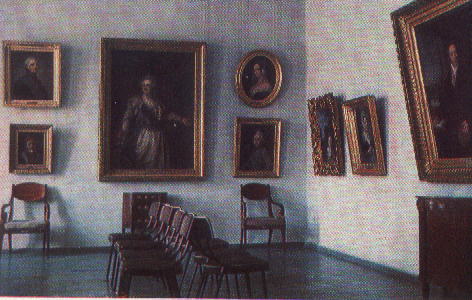 The
Omsk State Museum of Fine Arts is the largest collection of native and
forein works of arts in Syberia. On the 21 December, 1924, our museum was
inaugurated for visitors. Now the museum contains thousands exhibits: icons,
paintings, sculptures, plates and dishes, clocks, object of decorative
arts and others. We shall tell you only about some of them.
The
Omsk State Museum of Fine Arts is the largest collection of native and
forein works of arts in Syberia. On the 21 December, 1924, our museum was
inaugurated for visitors. Now the museum contains thousands exhibits: icons,
paintings, sculptures, plates and dishes, clocks, object of decorative
arts and others. We shall tell you only about some of them.
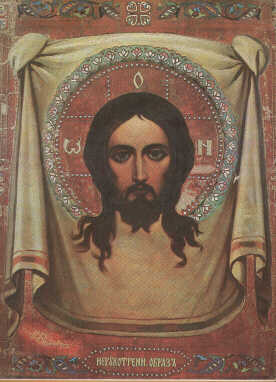
The icon "Spas Nerukotvorny" ("The Sacred
image not created by human hands"). An unknown painter of the Moskow
school created in at the XIX century. The icon was painted in commemoration
of legendary event having place at the time when Jesus had been going on
the Calvary. The Savior had wiped the face by a shawl and his wonderful
image not created by human hands appeared on the material.
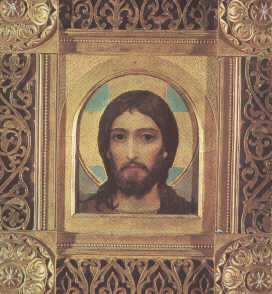
The icon "Spasitel" ("The Savior")
was painted by V. Vasnetsov. This painter worked at the wall-painting of
a large cathedral in Kiev for a long time. His icons have realistic images,
they are not canonical. This icon is in the fretted gilded frame.
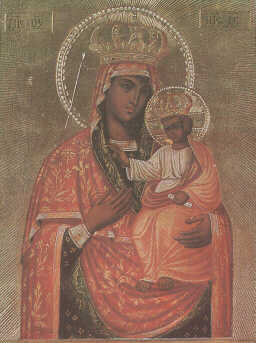
The icon "Bogomater Chernigovskaya" ("The
Virgin Chernigovskaya") is a work of an unknown painter (russian icon-painters
did not signed their works, because they thougth that their hands were
moving by God and therefore it was immodestly to put one's signature on
an icon). Portrayal on plank has the silver setting framework with enamel.
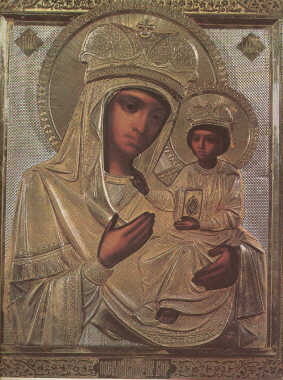
The icon "Bogomater Oseryanskaya" ("The
Virgin Oseryanskaya") was painted in 1896 in Moscow. The icon has
the silver setting framework with coinage except the faces and hands of
Virgin and Jesus.
The section of Russian painting contains a great number
of outstanding pictures of famous painters. We have chosen only three of
them.
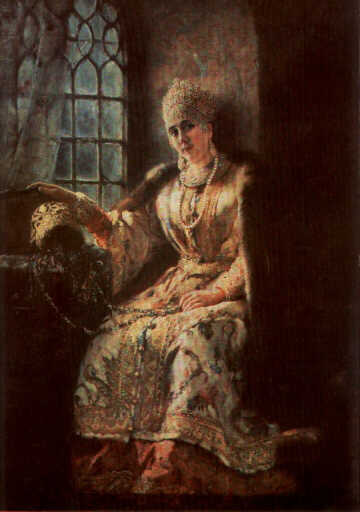 The
canvas "Boyard's wife by the window" was painting by Konstantin
Makovsky in 1885. The young married woman is in the boyard's tower. She
is sitting near the casket with jewels. She is in brocade, the sables fur-coat,
the pearl kokoshnik (women's headdress in old Russia) and the pearl necklace.
The little cap with gold embroidery is on the table. Russian boyarynias
of XIV-XVII centuries lived as recluses, going out their towers only to
the garden and the church. Their joys were only rich dresses and jewels.
This way of life was adopted by Russian boyards from Tatar aristocracy
living in Moscow. The oriental life is expressed by the oriental face's
type and the oriental dress material.
The
canvas "Boyard's wife by the window" was painting by Konstantin
Makovsky in 1885. The young married woman is in the boyard's tower. She
is sitting near the casket with jewels. She is in brocade, the sables fur-coat,
the pearl kokoshnik (women's headdress in old Russia) and the pearl necklace.
The little cap with gold embroidery is on the table. Russian boyarynias
of XIV-XVII centuries lived as recluses, going out their towers only to
the garden and the church. Their joys were only rich dresses and jewels.
This way of life was adopted by Russian boyards from Tatar aristocracy
living in Moscow. The oriental life is expressed by the oriental face's
type and the oriental dress material.
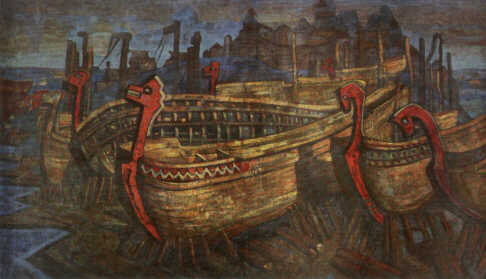 The
picture "Boats" was painted by Nicolay Raerich. Raerich was not
only a notable orientalist, a public figure ("The Raerich" pakt
in defence of culture during the war), but a famous painter as well. At
the beginning of the XX century he was interested in the history of Ancient
Russia and fond of writing historical pictures.
The
picture "Boats" was painted by Nicolay Raerich. Raerich was not
only a notable orientalist, a public figure ("The Raerich" pakt
in defence of culture during the war), but a famous painter as well. At
the beginning of the XX century he was interested in the history of Ancient
Russia and fond of writing historical pictures.
The wooden boats looked like Norman's ships are on the
picture. A wooden town-fortress is situated on the island far away.
Raerich visited Omsk in 1926 on the Himalayas. The painter
was very glad to find this picture in the Omsk Museum of Fine Arts. He
thought it to be left in St-Petersburg studio in 1916 and lost during the
October Revolution in 1917.
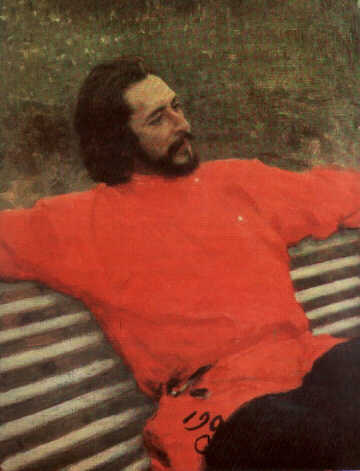 Iliya
Repin (1844-1930) is one of the most famous painters in Russia. He is an
author of many historical pictures and one of the best portrait-painters
of his epoch. He created portraits of simple russian muzhiks and russian
writers including Leo Tolstoy.
Iliya
Repin (1844-1930) is one of the most famous painters in Russia. He is an
author of many historical pictures and one of the best portrait-painters
of his epoch. He created portraits of simple russian muzhiks and russian
writers including Leo Tolstoy.
The portrait of a popular writer of the beginning of the
XX century Leonid Andreyev is in the collection of the Omsk Museum. There
is contrast of red and green colours at this portrait. It's a symbol of
tragedy and alarm of the writer's creative work and in his soul. This portrait
always attracts visitors attantion because a lot of them have read stories
and plays written by Leonid Andreyev.
The Omsk Museum of Fine Arts has a large collection of
the West-European painting, the ancient furniture, stone vases and jewerly
decorations. All people living in Omsk are proud of their museum.
Written by Alexander Adelshin & Anna Adelshina
 The
Omsk State Museum of Fine Arts is the largest collection of native and
forein works of arts in Syberia. On the 21 December, 1924, our museum was
inaugurated for visitors. Now the museum contains thousands exhibits: icons,
paintings, sculptures, plates and dishes, clocks, object of decorative
arts and others. We shall tell you only about some of them.
The
Omsk State Museum of Fine Arts is the largest collection of native and
forein works of arts in Syberia. On the 21 December, 1924, our museum was
inaugurated for visitors. Now the museum contains thousands exhibits: icons,
paintings, sculptures, plates and dishes, clocks, object of decorative
arts and others. We shall tell you only about some of them.



 The
canvas "Boyard's wife by the window" was painting by Konstantin
Makovsky in 1885. The young married woman is in the boyard's tower. She
is sitting near the casket with jewels. She is in brocade, the sables fur-coat,
the pearl kokoshnik (women's headdress in old Russia) and the pearl necklace.
The little cap with gold embroidery is on the table. Russian boyarynias
of XIV-XVII centuries lived as recluses, going out their towers only to
the garden and the church. Their joys were only rich dresses and jewels.
This way of life was adopted by Russian boyards from Tatar aristocracy
living in Moscow. The oriental life is expressed by the oriental face's
type and the oriental dress material.
The
canvas "Boyard's wife by the window" was painting by Konstantin
Makovsky in 1885. The young married woman is in the boyard's tower. She
is sitting near the casket with jewels. She is in brocade, the sables fur-coat,
the pearl kokoshnik (women's headdress in old Russia) and the pearl necklace.
The little cap with gold embroidery is on the table. Russian boyarynias
of XIV-XVII centuries lived as recluses, going out their towers only to
the garden and the church. Their joys were only rich dresses and jewels.
This way of life was adopted by Russian boyards from Tatar aristocracy
living in Moscow. The oriental life is expressed by the oriental face's
type and the oriental dress material. The
picture "Boats" was painted by Nicolay Raerich. Raerich was not
only a notable orientalist, a public figure ("The Raerich" pakt
in defence of culture during the war), but a famous painter as well. At
the beginning of the XX century he was interested in the history of Ancient
Russia and fond of writing historical pictures.
The
picture "Boats" was painted by Nicolay Raerich. Raerich was not
only a notable orientalist, a public figure ("The Raerich" pakt
in defence of culture during the war), but a famous painter as well. At
the beginning of the XX century he was interested in the history of Ancient
Russia and fond of writing historical pictures. Iliya
Repin (1844-1930) is one of the most famous painters in Russia. He is an
author of many historical pictures and one of the best portrait-painters
of his epoch. He created portraits of simple russian muzhiks and russian
writers including Leo Tolstoy.
Iliya
Repin (1844-1930) is one of the most famous painters in Russia. He is an
author of many historical pictures and one of the best portrait-painters
of his epoch. He created portraits of simple russian muzhiks and russian
writers including Leo Tolstoy.